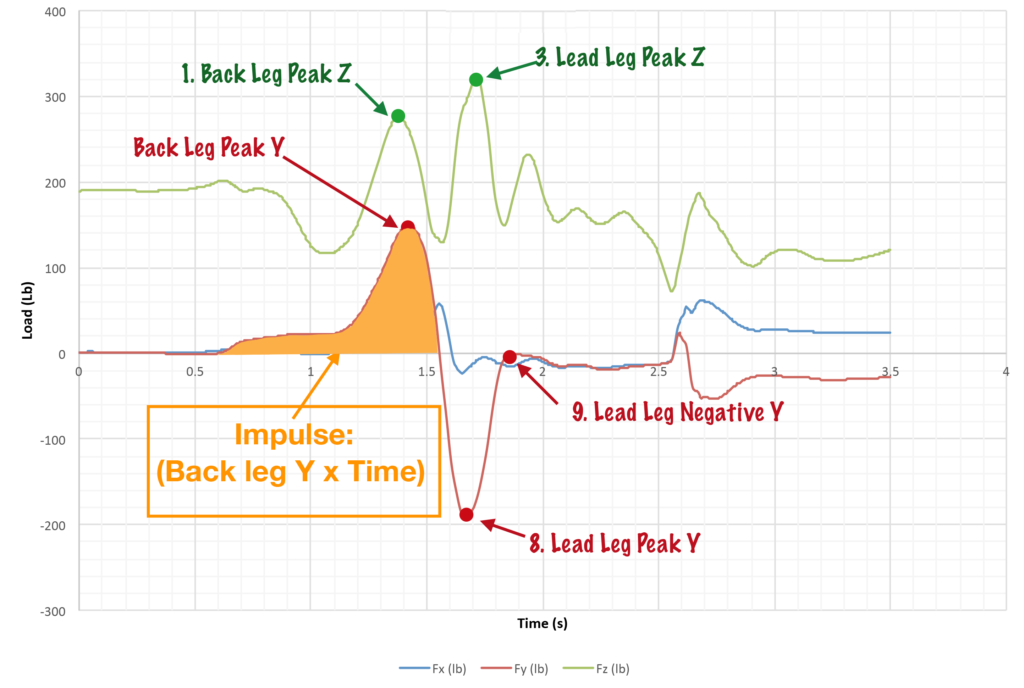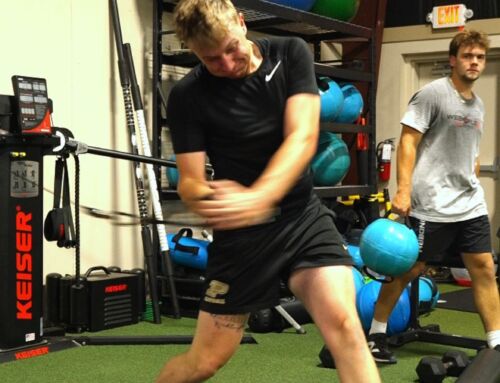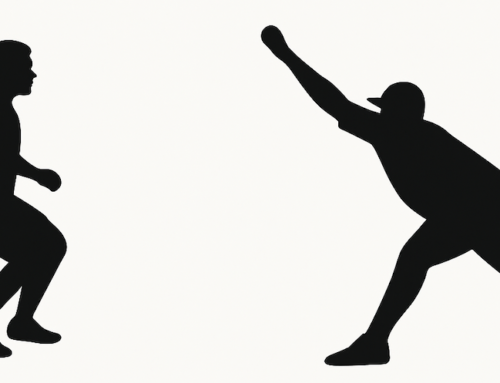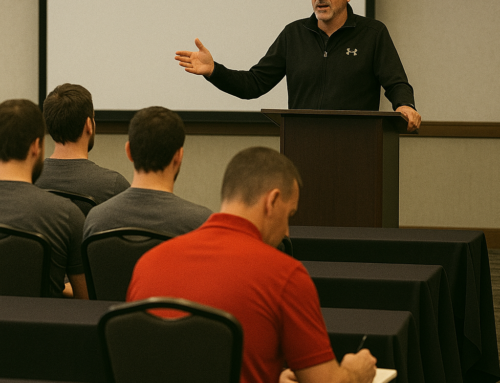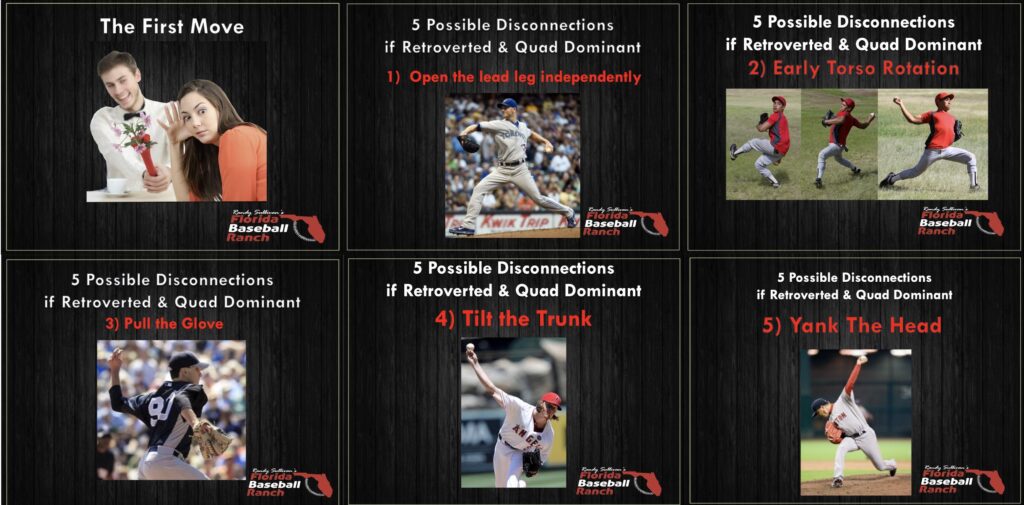
Anatomy Of A Pitcher’s Hip Hinge: First Move Nuance
In 2019, we concluded a ground reaction force study of 500 pitchers using a NewtForce sensored mound. This incredible new technology is the brainchild of a team of aeronautical engineers led by NewtForce CEO, Kyle Barker. Unlike typical force plates plagued by slippage and measurement error, the NewtForce mound uses an array of embedded sensors to measure and display ground reaction forces in real-time. It’s linked to 200 fps video, which allows us to identify the specific movement variables that influence force production.
To understand the application of this revolutionary technology, let’s examine a typical NewtForce report.
The green line is Z Force — how hard the athlete is pushing straight down into the ground
The red line is Y Force — how hard the athlete is pushing forward or backward. Positive Y is going toward second base. Negative Y is toward home plate.
The blue line is X Force — side-to-side force. Positive X is toward the 3rd base side, and Negative X is toward first base.
The vertical axis represents the amount of force (in pounds) produced, and the horizontal axis is the time (in seconds) that force is applied.
To begin the study, we named what we suspected to be valuable data points on the graph. Some of the metrics were amplitude-based (i.e., how much force was created). We also investigated timing factors and the interaction of multiple variables force/time-related variables. After the data was collected, we ran a machine learning algorithm called XG Boost to rank each data point relative to its importance for velocity. The algorithm produced some exciting findings.
The number one contributor to velocity was “impulse.” Impulse is defined as the amount of positive Y force (in pounds) generated multiplied by the time (in seconds) that force was applied. For example, if you create 100 pounds of Y force toward second base and hold it for a half-second, your impulse is 50. On the NewtForce graph, the impulse is represented by the area under this curve.
It’s not a linear relationship. More impulse doesn’t necessarily mean more velocity. Remember, in a dynamic system, there are no cause and effect relationships. Likewise, a lower impulse doesn’t mean you can’t throw hard. The XGBoost top-ranking merely recognizes impulse as the most influential of several important variables for predicting velocity. That said, if you’re trying to gain velocity, increasing your impulse is a great starting point.
So how does a pitcher increase his impulse?
You might think increasing impulse would be simply a matter of pushing harder off the rubber with your back leg, but that won’t get it done. If you push harder 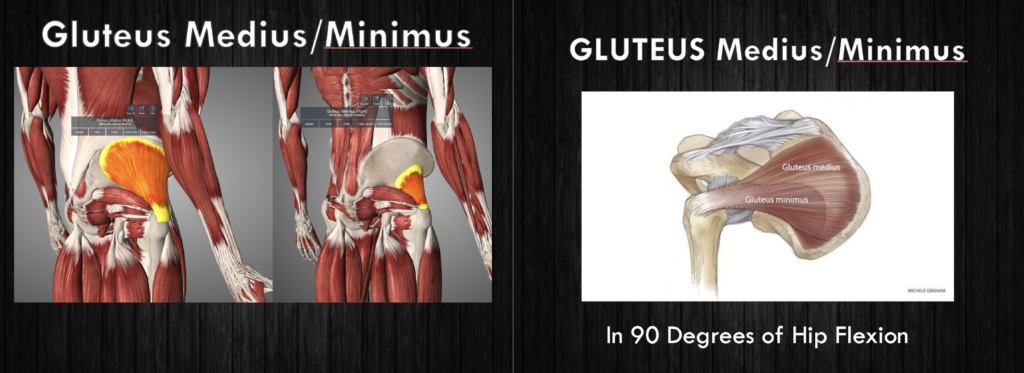 toward second base, the amount of force created will probably increase, but the time that force is applied will likely decrease. The Y force graph will spike vertically, but it will also become thinner horizontally. The net gain in impulse will be minimal.
toward second base, the amount of force created will probably increase, but the time that force is applied will likely decrease. The Y force graph will spike vertically, but it will also become thinner horizontally. The net gain in impulse will be minimal.
The best way to increase impulse is to hinge your back hip. In a modest hinge, the powerful little glutes (the medius and minimus) are moved to an optimal length for power, control, and stability and stability of the pelvis.
What is “optimal length?”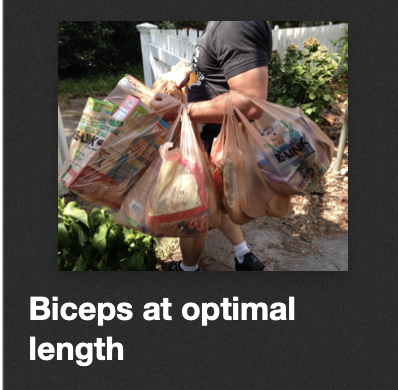
Every muscle or group of muscles has a length at which it is the most strong and stable. For example, when your elbow is fully straightened, the biceps is weak because it is too long. When the elbow is fully bent, the muscle is ineffective because it is too short. For every individual, there is a sweet spot somewhere in the middle where the biceps is “optimally lengthened” for maximal force production and stability.
When you lift your lead leg and then hinge your back hip, you place the little glutes at the perfect length to powerfully tilt the front side of the pelvis upward. This allows you to hold your ride, resist the mound’s slope, sustain your rearward (positive) Y force, and expand your impulse.
Important note: It’s the back hip that tilts the pelvis, not the front hip.
Attempting to tilt the pelvis by hiking the lead hip upward shortens the little glutes, moving them away from optimal length. The result is often a dampened impulse.
Tilting your upper body laterally toward second base also shortens the little glutes, flattens the pelvis, and suppresses impulse.
Reaching with the lead leg in an attempt to create an artificially long stride turns the little glutes off, flattens the pelvis, and squelches impulse.
Shifting the weight to the ball of the foot causes the back knee to drift forward of the rear toe. This activates the quads, inhibits the little glutes, and can stifle impulse.
Here’s a tip:
Look down at your back foot as you’re bending your back knee. If you can’t see your toes (because your knee is in the way), you’re lunging, not hinging. Lunging  is a quad-dominant move. The quads can’t tilt the pelvis. They can only cause you to leap toward the on-deck circle.
is a quad-dominant move. The quads can’t tilt the pelvis. They can only cause you to leap toward the on-deck circle.
If you bend your back knee and look down at your toes and you can see your toes, you’re hinging, not lunging. Hinging turns on the little glutes.
Failure to hinge isn’t necessarily fatal. You may be able to compensate for the lack of impulse further downstream if you have the right hardware for the job. Still, when your first move is a quality hinge, things get a lot easier. With the right first move, many subsequent performance indicators fall into place naturally.
Options for managing your back leg and pelvis are intimately interwoven with your hardware — your physical structure. Some hardware can be changed, some can’t. If you have tight hamstrings, we can improve that. But we can’t change your bone structure.
For example, some people have hip sockets that point outward and are positioned rearward on the pelvis. The medical term for that is “retroverted hips.” People with retroverted hips stand with their toes pointing outward (like a duck). They sit “criss-cross-apple sauce” comfortably, and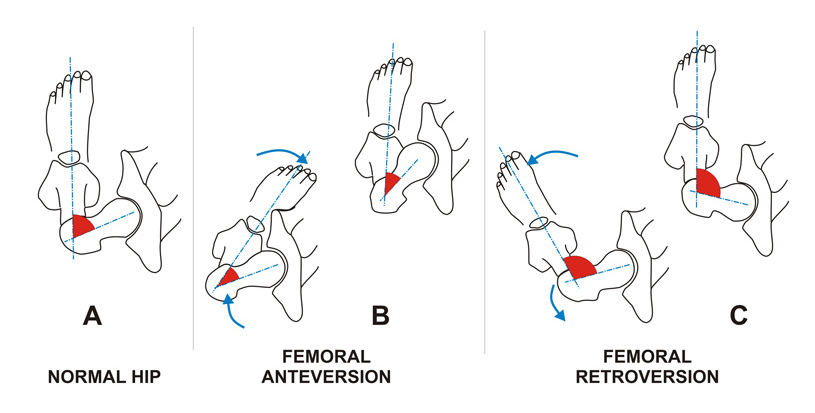 when they sit in a chair, they prop one heal up on the opposite knee to cross their legs. Retroverts tend to prefer external rotation of their hips, but they’re not crazy about internal rotation.
when they sit in a chair, they prop one heal up on the opposite knee to cross their legs. Retroverts tend to prefer external rotation of their hips, but they’re not crazy about internal rotation.
Anteverted hips sit forward on the pelvis and point inward. Athletes with anteverted hips are pigeon-toed, and they usually stand with their legs crossed. They have a hard time sitting with their legs crossed on the floor, and they prefer internal rotation to external rotation.
If your hips are anteverted, and you make a quad dominant first move that projects you toward the arm side on deck circle, you might be ok. Unless you’re extremely far across your body, you might have enough range of motion available to rotate around your lead hip and get your arm moving toward home plate. This assumes, of course, that you have at least a minimally acceptable amount thoracic rotation mobility.
If your hips are retroverted and your first move is quad dominant, well that’s an entirely different story. When the direction of your load is across your body, you’ll probably need to make a few mid-air corrections. Options could include pulling hard with the glove side arm, opening the torso early, eventually run out of room to rotate around your front hip. Unless you plan on throwing the ball into the dugout, you’re going to need to compensate. Alternative movement options could include one or more of the following: 1) opening your lead leg early, 2) Prematurely turning the torso toward home plate 3) Pulling hard with the glove side arm 4) Tilting your trunk toward the glove side 5) Yanking the head laterally.
your body, you’ll probably need to make a few mid-air corrections. Options could include pulling hard with the glove side arm, opening the torso early, eventually run out of room to rotate around your front hip. Unless you plan on throwing the ball into the dugout, you’re going to need to compensate. Alternative movement options could include one or more of the following: 1) opening your lead leg early, 2) Prematurely turning the torso toward home plate 3) Pulling hard with the glove side arm 4) Tilting your trunk toward the glove side 5) Yanking the head laterally.
Once your lead leg lands you may also choose from a few other potentially corruptive options: 1) Flex your back hip or take it airborne and vault over your back leg. 2) Let the front knee wobble laterally, making it virtually impossible to stop the pelvis from continued rotation. Failure to stop the pelvis could prevent you from getting your upper body to rotate toward the plate.
Any or all of these can situations can create dangerous shear forces or move key musculature (e.g., the abdominals and back muscles) away from optimal length.
 In Frans Bosch’s book Anatomy of Agility, the author identifies and explains several universal movement characteristics common to all athletic endeavors. Most of these so-called “attractors” are built around the concept of maintaining optimal length. Bosch identifies one key attractor as “Rotation Round The Hip.” We think of it as a dynamic hip hinge. If you’re Barry Sanders and you have to change directions rapidly, putting your foot in the ground and hinging your plant leg hip is extremely useful.
In Frans Bosch’s book Anatomy of Agility, the author identifies and explains several universal movement characteristics common to all athletic endeavors. Most of these so-called “attractors” are built around the concept of maintaining optimal length. Bosch identifies one key attractor as “Rotation Round The Hip.” We think of it as a dynamic hip hinge. If you’re Barry Sanders and you have to change directions rapidly, putting your foot in the ground and hinging your plant leg hip is extremely useful.
Hinging the back hip is a crucial attractor, but not all hinges are alike.
In the gym, when teaching a two-legged hinge, most SCCs use dowels or counterweights to encourage symmetrical hinging in which the hips are driven 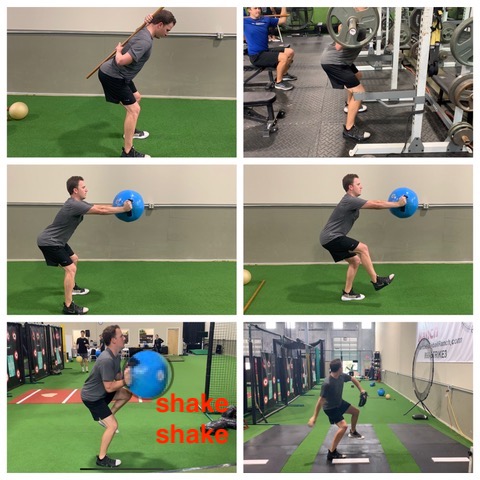 straight rearward. A one-legged hinge is a different animal. If you hinge on one leg straight backward, you’re probably creating shear forces in your hip joint. To seat the femur’s head directly in the socket (acetabulum), guys will probably need to rotate around the hip either internally or externally to some degree. This might involve turning the back and buttocks slightly toward the hitter, a move we call counter-rotation. You might also see them find stability by screwing the back foot into the ground, causing the knee to point toward the shortstop. Guys with retroverted hips might find comfort in positioning the foot with the heel a few inches from the rubber. Counter-rotation and/or external rotation of the back hip, while hinging can be beneficial for a retroverted athlete. Take caution, however. Counter-rotation of the torso or externally rotating the hip without also hinging can create sheer forces and inhibit the little glutes.
straight rearward. A one-legged hinge is a different animal. If you hinge on one leg straight backward, you’re probably creating shear forces in your hip joint. To seat the femur’s head directly in the socket (acetabulum), guys will probably need to rotate around the hip either internally or externally to some degree. This might involve turning the back and buttocks slightly toward the hitter, a move we call counter-rotation. You might also see them find stability by screwing the back foot into the ground, causing the knee to point toward the shortstop. Guys with retroverted hips might find comfort in positioning the foot with the heel a few inches from the rubber. Counter-rotation and/or external rotation of the back hip, while hinging can be beneficial for a retroverted athlete. Take caution, however. Counter-rotation of the torso or externally rotating the hip without also hinging can create sheer forces and inhibit the little glutes.
Anteverted pitchers will probably be more comfortable and/or powerful with a little more internal rotation during the hinge. This could result in an acceptable level of quad dominance. They might find comfort turning their foot, so their toes are a few inches off the rubber.
It’s also important to remember that anteversion vs. retroversions is not black and white, yes or no condition. Athletes will present with hips that are oriented anywhere on the anteversion, retroversion spectrum. Some will be more extreme than others.
If that’s all there was to it, hip orientation would be reasonably easy to understand. Of course, it gets a little more complicated. Retroversion vs. anteversion only explains a piece of this infinitely complex puzzle. There are six degrees of freedom of motion in the hip. It can move into flexion, extension, internal rotation, external rotation abduction, and adduction. That presents a difficult enough problem to solve. But each individual hip socket (the acetabulum) can be positioned and oriented in any combination or of six different locations/directions. The hip socket can be located forward or back on the pelvis. It can also be  situated up or down. Or, it can face inward or outward anywhere along a -degree spectrum.
situated up or down. Or, it can face inward or outward anywhere along a -degree spectrum.
Additionally, as it moves around in the socket, the femoral head can slide or translate in any direction, and it can move through any gradation of roll, tilt, and yaw. The possible permutations are limitless and would be impossible to control without isometric co-contraction of all the muscles around the hip. Co-contraction limits the number of degrees of freedom the athlete must manage. Co-contraction with muscles at optimal length is motor control nirvana.
According to Frans Bosch, “Posture information is probably is less important for control than inertia (changing forces) information.”
When a body is exposed to unpredictable loads or time pressure, it reverts to its reflex of isometric co-contraction of all the muscles around joints or limbs. If you’ve ever held a squirming baby, caught a big fish, or nearly sprained your ankle in a hole, you’ve experienced an isometric co-contraction.
When designing training programs, we should encourage every athlete to explore dynamic one-legged hinges at varying degrees of internal/external rotation, and/or torso counter-rotation. We should also have them play with variable weight distributions (toward the heel/toe or inside/outside of the foot). Eventually, the athlete will find the sweet spot that suits them the most. When their training experiences expose them to unpredictable loads and/or time pressure, they will learn to subconsciously execute the well-timed co-contractions required to stabilize their joints and optimize their movement.
When a body is exposed to unpredictable loads or time pressure, it reverts to its reflex of isometric co-contraction of all the muscles around joints or limbs. If  you’ve ever held a squirming baby, caught a big fish, or nearly sprained your ankle in a hole, you’ve experienced isometric co-contraction.
you’ve ever held a squirming baby, caught a big fish, or nearly sprained your ankle in a hole, you’ve experienced isometric co-contraction.
We teaching a pitcher to manage his back hip, we should design training experiences that introduce unpredictable loads and time pressure that will provide loud sensory information. That information should be presented in the form of forces and inertia rather than postural or cognitive cues. Exposure to powerful, rapid, and unpredictable force will demand and elicit the co-contractions necessary to limit degrees of freedom and stabilize the back hip.
When the athlete finds his individual sweet-spot, he’ll know it. He’ll feel it. The movement will be so calorie preservative and energy-efficient that he’ll release addictive hormones (dopamine, serotonin, epinephrine, and oxytocin). Like a drug addict chasing a fix, he’ll seek out the movement that created the hormone-releasing experience. Over time, the bandwidth of deviations will narrow. As the movement stabilizes, performance outcomes like velocity, command, and ball flight characteristics will be optimized.
A well-executed one-legged hinge is vital to increasing impulse and improving velocity. But, not all hinges are the same. The single-leg hinge must be nuanced to link the athlete’s hardware to his software. This requires an in-depth investigation and appreciation of each athlete’s unique physical characteristics and movement preferences. A well-designed training plan, coupled with an environment that encourages guided exploration of movement solutions, can lead to transformational performance gains.
We’ll see you at The ARMory.
Stay SAVAGE!
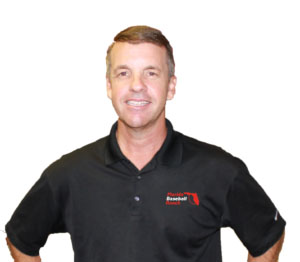
Randy Sullivan, MPT, CSCS CEO, Florida Baseball ARMory



